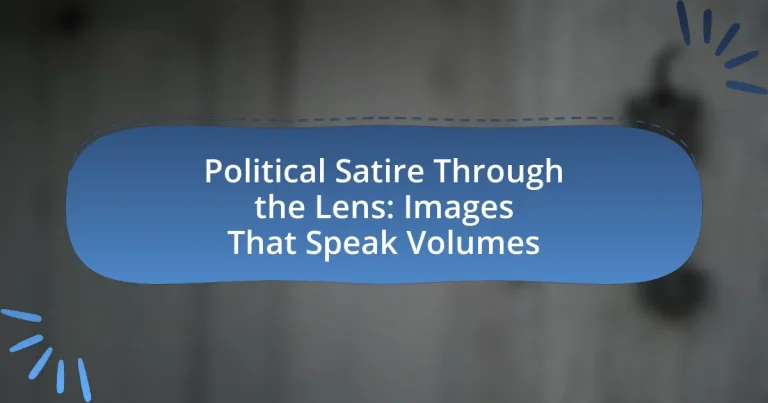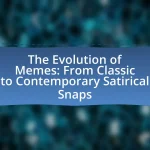Political satire through the lens refers to the use of visual imagery to critique political events, figures, and ideologies, employing techniques such as caricature, exaggeration, and symbolism. This article explores how political satire utilizes visual imagery to convey complex messages, the key elements that define it, and its historical roots. It also examines the evolution of political satire, its significance in contemporary society, and the ethical considerations surrounding its creation. Additionally, the article discusses the impact of satire on public opinion and awareness, the various styles of political satire, and strategies for effectively engaging with and analyzing satirical content.
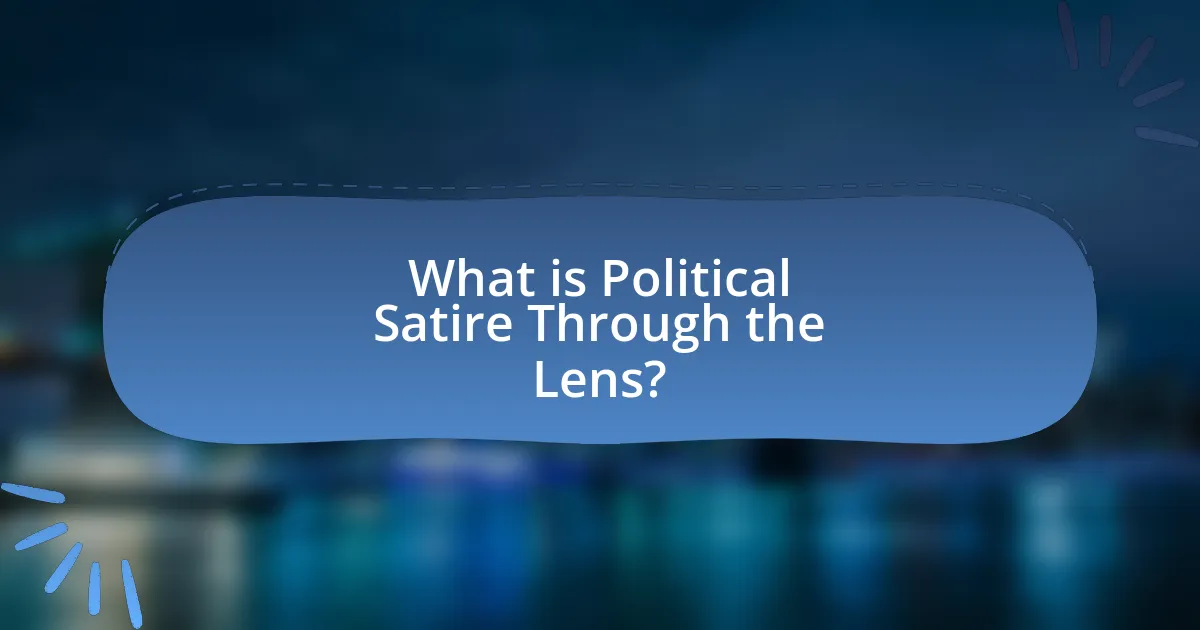
What is Political Satire Through the Lens?
Political satire through the lens refers to the use of visual imagery to critique and comment on political events, figures, and ideologies. This form of satire employs techniques such as caricature, exaggeration, and symbolism to convey messages that provoke thought and discussion about political issues. Historical examples include political cartoons from the 18th and 19th centuries, which often highlighted the absurdities of political power and governance, demonstrating how visual art can effectively communicate complex political sentiments to a broad audience.
How does political satire utilize visual imagery?
Political satire utilizes visual imagery to convey complex political messages and critique societal issues effectively. By employing caricatures, exaggerated features, and symbolic representations, political satire distills intricate political narratives into easily digestible visuals. For instance, the use of iconic symbols, such as the elephant for the Republican Party or the donkey for the Democratic Party, allows audiences to quickly grasp the underlying political commentary. Historical examples include the political cartoons of Thomas Nast in the 19th century, which used visual satire to expose corruption and advocate for social reform, demonstrating the power of imagery in shaping public opinion and discourse.
What are the key elements of visual political satire?
The key elements of visual political satire include exaggeration, symbolism, caricature, and context. Exaggeration amplifies features or behaviors of political figures to highlight absurdities, while symbolism uses images or objects to represent broader political ideas or critiques. Caricature distorts physical traits or characteristics of politicians to evoke humor or criticism, and context situates the satire within current events or societal issues, enhancing its relevance and impact. These elements work together to create a powerful commentary on political situations, as seen in works by artists like Thomas Nast, whose illustrations in the 19th century effectively used these techniques to critique corruption and influence public opinion.
How do images convey political messages effectively?
Images convey political messages effectively by utilizing visual symbolism, emotional appeal, and context to communicate complex ideas quickly and powerfully. For instance, iconic images like the “Tank Man” during the Tiananmen Square protests encapsulate resistance and defiance against oppression, resonating emotionally with viewers and prompting reflection on political issues. Research indicates that visuals can enhance memory retention by up to 65% compared to text alone, making images a potent tool for political communication. This effectiveness is further supported by studies showing that images can evoke immediate emotional responses, which are crucial in shaping public opinion and mobilizing action.
Why is political satire important in contemporary society?
Political satire is important in contemporary society because it serves as a critical tool for social commentary and political engagement. By using humor and irony, political satire exposes the absurdities and contradictions within political systems, encouraging citizens to question authority and engage in discourse. For instance, shows like “Saturday Night Live” and “The Daily Show” have historically influenced public opinion and voter behavior, as evidenced by studies indicating that viewers of satirical content are more informed about political issues compared to non-viewers. This highlights the role of political satire in fostering a more informed electorate and promoting democratic participation.
What role does satire play in political discourse?
Satire plays a critical role in political discourse by providing a means to critique and challenge political figures and policies through humor and exaggeration. This form of expression allows individuals to engage with complex political issues in a more accessible manner, often highlighting absurdities and contradictions within political narratives. For instance, satirical programs like “The Daily Show” and “Saturday Night Live” have historically influenced public opinion and voter behavior by using comedic commentary to expose corruption and hypocrisy in politics. Research indicates that exposure to political satire can increase political awareness and engagement, as it encourages audiences to think critically about the information presented.
How does satire influence public opinion and awareness?
Satire influences public opinion and awareness by using humor and exaggeration to critique societal norms and political issues. This form of expression engages audiences, making complex topics more accessible and prompting critical thinking. For instance, studies have shown that political satire can increase political knowledge and engagement among viewers, as evidenced by research from the Pew Research Center, which found that individuals who consume satirical content are more likely to discuss political issues and participate in civic activities. By highlighting absurdities in politics, satire encourages audiences to question authority and consider alternative viewpoints, ultimately shaping public discourse.
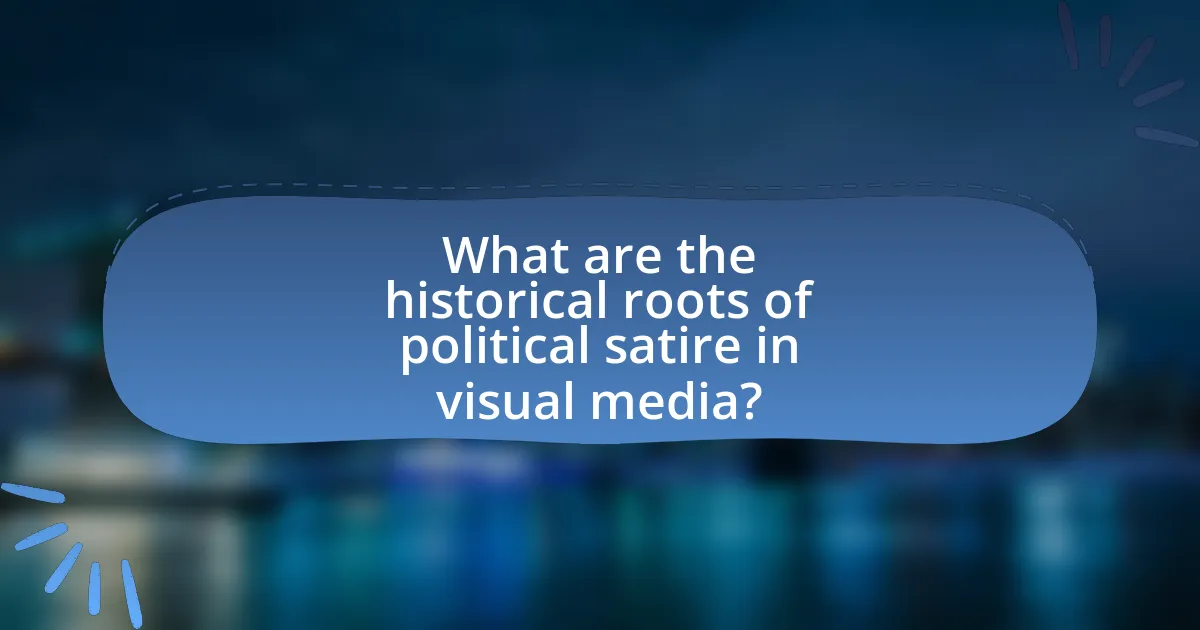
What are the historical roots of political satire in visual media?
The historical roots of political satire in visual media can be traced back to ancient civilizations, particularly in Greece and Rome, where caricatures and illustrations were used to critique political figures and societal norms. For instance, the Greek playwright Aristophanes employed visual elements in his plays to satirize political leaders, while Roman satirists like Juvenal used illustrations to convey their messages. The development of printmaking in the 16th century further propelled political satire, with artists like Hans Holbein and later, James Gillray, creating satirical engravings that commented on contemporary politics. These visual forms of satire became powerful tools for public discourse, influencing public opinion and political thought throughout history.
How has political satire evolved over time?
Political satire has evolved significantly from its origins in ancient Greece and Rome to contemporary forms in digital media. Initially, political satire was expressed through theatrical performances and literature, with figures like Aristophanes using comedy to critique political leaders and societal norms. Over time, the advent of print media in the 18th century allowed for the widespread distribution of satirical cartoons and pamphlets, exemplified by artists like James Gillray in England, who targeted political figures through caricature.
In the 20th century, political satire transitioned into radio and television, with programs like “Saturday Night Live” and “The Daily Show” shaping public discourse through humor and parody. The rise of the internet in the 21st century further transformed political satire, enabling rapid dissemination and engagement through social media platforms, where memes and short videos became prevalent. This evolution reflects a shift from traditional forms of satire to more immediate and interactive formats, allowing audiences to participate in the political conversation.
What significant movements or events shaped visual political satire?
Significant movements that shaped visual political satire include the Enlightenment, the rise of print media, and major political revolutions such as the French Revolution. The Enlightenment fostered critical thinking and skepticism towards authority, leading to the creation of satirical works that challenged political norms. The advent of print media in the 18th century allowed for wider distribution of satirical illustrations, exemplified by artists like James Gillray, who used caricature to comment on political events. The French Revolution further propelled visual satire as artists depicted the tumultuous political landscape, influencing public opinion and engagement. These movements collectively established visual political satire as a powerful tool for social commentary and critique.
How did early forms of political satire influence modern practices?
Early forms of political satire laid the groundwork for modern practices by establishing techniques of humor and critique that remain relevant today. For instance, the use of caricatures in 18th-century publications like “The Spectator” allowed satirists to exaggerate political figures’ traits, a method that continues in contemporary political cartoons. Additionally, the satirical works of figures such as Jonathan Swift and Voltaire employed irony and wit to challenge authority, influencing modern satirists like Jon Stewart and John Oliver, who similarly use humor to address political issues. This historical lineage demonstrates how early satire not only shaped public discourse but also provided a framework for engaging audiences through humor, making complex political topics more accessible and stimulating critical thought.
What are the different styles of political satire in imagery?
Political satire in imagery encompasses various styles, including caricature, editorial cartoons, and visual metaphors. Caricature exaggerates physical features or traits of political figures to highlight their flaws or absurdities, often making them instantly recognizable and humorous. Editorial cartoons combine visual art with commentary, using humor and irony to critique political events or policies, as seen in the works of artists like Thomas Nast in the 19th century. Visual metaphors employ symbolic imagery to convey complex political ideas succinctly, allowing viewers to grasp nuanced critiques quickly. These styles effectively engage audiences by combining humor with critical commentary, making political issues more accessible and thought-provoking.
What distinguishes caricature from editorial cartoons?
Caricature is distinguished from editorial cartoons primarily by its focus on exaggerated physical features and characteristics of individuals, often to highlight their personality traits or flaws. While both forms utilize humor and satire to comment on social or political issues, caricatures emphasize the distortion of likeness to provoke thought or amusement about the subject’s identity. In contrast, editorial cartoons typically address broader themes or events, using visual metaphors and symbolism to convey opinions on political or social matters without necessarily focusing on individual likenesses. This distinction is evident in the historical context where caricatures have roots in portraiture, while editorial cartoons emerged as a means of commentary in publications, such as those seen in the 18th-century British press.
How do memes serve as a modern form of political satire?
Memes serve as a modern form of political satire by using humor and visual imagery to critique political figures and policies. This medium allows for rapid dissemination of ideas, often simplifying complex political issues into easily digestible content that resonates with a wide audience. For instance, during the 2016 U.S. presidential election, memes targeting candidates like Donald Trump and Hillary Clinton became viral, illustrating public sentiment and shaping perceptions. Research indicates that memes can influence political discourse, as they often reflect and amplify societal attitudes, making them a powerful tool for satire in contemporary politics.
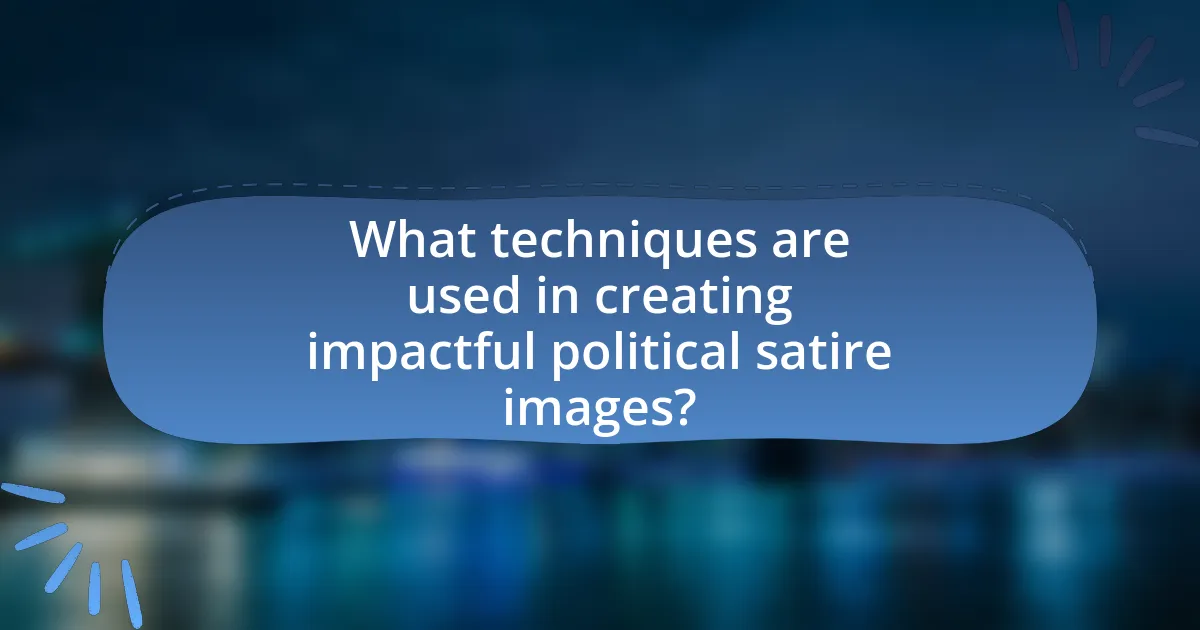
What techniques are used in creating impactful political satire images?
Impactful political satire images are created using techniques such as exaggeration, symbolism, and juxtaposition. Exaggeration amplifies features or actions of political figures to highlight absurdities, making the message more striking. Symbolism employs visual metaphors to convey complex ideas succinctly, allowing viewers to grasp deeper meanings quickly. Juxtaposition places contrasting elements side by side, often revealing contradictions in political narratives or policies. These techniques have been effectively utilized in historical contexts, such as the political cartoons of Thomas Nast in the 19th century, which played a significant role in shaping public opinion through visual satire.
How do artists choose their subjects for satire?
Artists choose their subjects for satire by identifying social, political, or cultural issues that provoke strong reactions or highlight absurdities. They often focus on current events, public figures, or societal norms that are ripe for critique, aiming to provoke thought and discussion. For instance, political cartoonists frequently target politicians or government policies that are controversial or widely debated, as these subjects resonate with audiences and can effectively convey a message. Historical examples include the works of artists like Honoré Daumier, who used satire to comment on the injustices of his time, demonstrating that the choice of subject is often influenced by the desire to reflect societal truths and challenge the status quo.
What factors influence the selection of imagery in political satire?
The selection of imagery in political satire is influenced by cultural context, audience demographics, and the political climate. Cultural context shapes the symbols and references that resonate with viewers, while audience demographics determine the effectiveness of specific imagery based on shared values and experiences. The political climate also plays a crucial role, as current events and prevailing sentiments dictate which issues are highlighted and how they are visually represented. For example, during election cycles, imagery often targets candidates’ characteristics or policies, utilizing recognizable symbols to enhance the satirical message.
How does context affect the interpretation of satirical images?
Context significantly influences the interpretation of satirical images by providing the necessary background that shapes viewer understanding. For instance, an image depicting a politician in a compromising situation may be interpreted as humorous or critical depending on the political climate, cultural norms, and current events surrounding that politician. Research indicates that viewers’ prior knowledge and experiences directly affect their perception; a study published in the Journal of Visual Culture found that individuals familiar with the political context were more likely to grasp the intended satire than those who were not. Thus, context serves as a lens through which satirical images are understood, impacting their effectiveness and reception.
What are the ethical considerations in political satire?
The ethical considerations in political satire include the balance between freedom of expression and the potential for harm. Political satire can serve as a tool for social critique and accountability, yet it risks perpetuating misinformation, reinforcing stereotypes, or inciting violence. For instance, the portrayal of political figures in a derogatory manner may lead to public misperceptions, as seen in the backlash against certain satirical depictions that misrepresent facts. Additionally, the impact of satire on public discourse raises questions about responsibility; creators must consider the consequences of their work on societal attitudes and behaviors.
How can political satire cross the line into offensive territory?
Political satire can cross into offensive territory when it targets marginalized groups or employs hate speech, reinforcing harmful stereotypes. For instance, satire that mocks the physical appearance, ethnicity, or beliefs of individuals from these groups can perpetuate discrimination and social division. Historical examples include cartoons that caricature racial minorities, which have been widely criticized for promoting racism and intolerance. Such instances demonstrate how satire, while intended to critique power structures, can inadvertently contribute to societal harm when it lacks sensitivity and awareness of its impact.
What responsibilities do artists have when creating satirical content?
Artists have the responsibility to ensure that their satirical content is both thought-provoking and respectful, avoiding the perpetuation of harmful stereotypes or misinformation. This responsibility stems from the potential impact of satire on public discourse and societal attitudes, as seen in historical examples where satirical works have influenced political movements or social change. For instance, the satirical cartoons of the early 20th century played a significant role in shaping public opinion during major political events, demonstrating the power of satire to inform and provoke critical thought while also necessitating a careful approach to avoid misinterpretation or offense.
How can individuals engage with political satire effectively?
Individuals can engage with political satire effectively by critically analyzing the content and context of the satire presented. This involves understanding the underlying messages, recognizing the use of humor as a tool for critique, and being aware of the political landscape that informs the satire. Engaging with political satire also requires individuals to share their interpretations and reactions through discussions or social media, thereby fostering a dialogue around the issues being satirized. Research indicates that political satire can enhance political engagement and awareness, as seen in studies showing that audiences who consume satirical content are more likely to discuss political issues and participate in civic activities.
What strategies can enhance understanding of satirical imagery?
To enhance understanding of satirical imagery, one effective strategy is to analyze the context in which the imagery is created, including the political and social climate at the time. Understanding the historical background and the specific events being referenced allows viewers to grasp the underlying messages and critiques embedded in the imagery. For instance, satirical cartoons often draw on current events, making it essential to be aware of those events to fully appreciate the satire. Additionally, engaging in discussions or critiques of the imagery can deepen comprehension, as sharing perspectives often reveals nuances that may not be immediately apparent. This approach is supported by studies indicating that collaborative interpretation enhances critical thinking and analytical skills, which are crucial for deciphering complex satirical content.
How can one critically analyze political satire in media?
One can critically analyze political satire in media by examining the underlying messages, techniques, and context used in the satire. This involves identifying the target of the satire, understanding the cultural and political context in which it was created, and evaluating the effectiveness of the humor in conveying its message. For instance, a study by the Pew Research Center found that political satire often reflects public sentiment and can influence political opinions, demonstrating its significance in shaping discourse. Analyzing elements such as exaggeration, irony, and parody helps to uncover the satirist’s intent and the societal issues being addressed, providing a comprehensive understanding of the satire’s impact.
